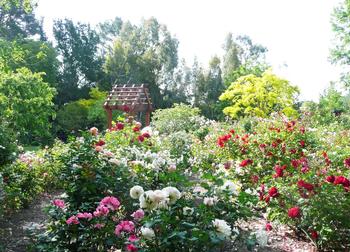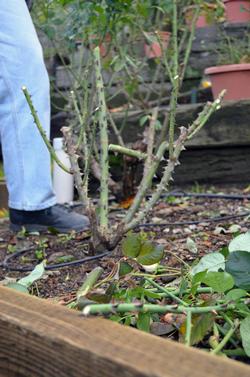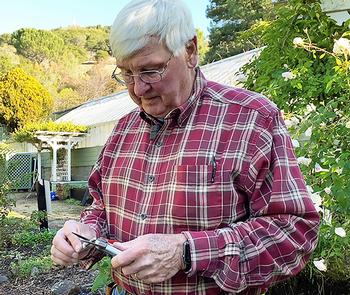For a bounty of roses, prune now
-
Nanette Londeree
-
I love roses. There’s nothing quite like walking through the garden in May and feasting on a bonanza of beauty, color, form, and fragrance. To get a bounty of flowers, besides sun, water and good soil, roses need to be pruned. And now is prime pruning season.
 Prune roses now for a bountiful bloom in the spring. Photo Credit: Nanette Londeree
Prune roses now for a bountiful bloom in the spring. Photo Credit: Nanette LondereeEven as an avid gardener, this is not my favorite task, especially with more than 500 rose bushes to prune. Over decades of doing this annual chore, I’ve honed the process to make the job as easy as possible, doing most of the work between the year-end holidays and Valentine’s Day, when the plants are dormant.
Why prune roses? Mostly to keep them healthy and productive and to give them an overall attractive shape. Removing the three D’s – dead, damaged, or diseased wood, crossing canes, anything thinner than a pencil, and reducing the plant volume by one-third to one-half are the goals of pruning. Roses will survive without it, but are likely to be weak, poorly shaped plants with smaller blooms, and more prone to pests and diseases.
You can get a terrific introduction to rose pruning basics in our new 12-minute video, “How to Prune Roses in Winter” available on the Marin Master Gardener website (marinmg.ucanr.edu/) and on our YouTube channel. UC Marin Master Gardener Don Chapman, also an American Rose Society Consulting Rosarian, walks through the basics of rose pruning for this time of year including tools to use, how to make cuts, and even how to prune a climbing rose.
Here are some things to simplify your pruning process: Winter pruning involves removing one-third to one-half of the rose. Photo Credit: Lenore Ruckman
Winter pruning involves removing one-third to one-half of the rose. Photo Credit: Lenore RuckmanKnow your rose: When and how to prune depends on what type of rose you’re working with. Species roses and many old garden varieties that bloom once a year should NOT be pruned now, or you’ll lose all the spring flowers. Repeat bloomers, those that have several flushes of flowers spring to fall, are the plants to prune now.
Start with the end in mind: After pruning your plant, you’ll want three to seven well-spaced sturdy, healthy canes about 18 inches tall, in a vase-shaped configuration with an open interior. Keep this visual in mind as you begin your work.
Be bold: Winter pruning involves removing one-third to one-half of the rose, so look at ways to reduce large portions at a time, rather than a series of cuts. Work from the ground up instead of nibbling away from the top down. If an old cane is no longer producing much new growth or flowers, consider removing it at its origin using loppers or a pruning saw. Don’t let the "decisions" about what to cut make you tense or slow you down.
Do it in stages: Take on the 80/20 approach; get the first 80 percent of the rose done, then a week or two later, come back and make your final cuts. This method allows you to remove a lot of bulk in and around the rose and gives you a clearer picture of the rose for the final, what I call, “fine tuning” pruning.
Make it easy on yourself: Use the best tools you can afford and keep them sharp! Good sized canes can be cut like butter with very sharp bypass pruners. Cuts are cleaner, and it’s a lot less tiring for your hands. Use a garden stool or seat to get up close to the plant, reducing the amount of bending and stretching. Try hedge shears for miniature and some landscape roses that have lots of very thin canes. And have your recycling can right next to you when pruning; cuttings go directly into the can and save you time and effort. Keep your pruners sharp for cleaner cuts and less work for your hands. Photo Credit: UC Marin Master Gardeners
Keep your pruners sharp for cleaner cuts and less work for your hands. Photo Credit: UC Marin Master GardenersDon’t be overly concerned about getting cuts “just right”. Once you realize that there is not too much you can do wrong, it makes the whole job much easier. Kind of like getting your hair cut too short – it will grow back!



